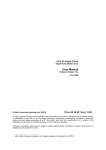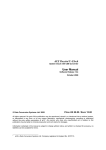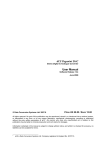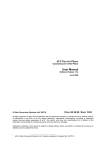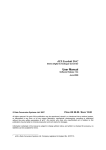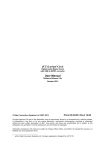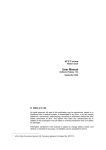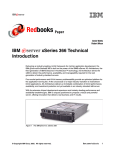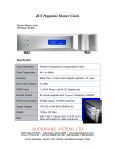Download Paganini Clock User Manual v1.0x
Transcript
dCS Paganini Clock Digital Audio Master Clock User Manual Software Release 1.0x June 2008 © Data Conversion Systems Ltd. 2007-8 Price UK £8.00 / Euro 12.00 All rights reserved. No part of this publication may be reproduced, stored in or introduced into a retrieval system, or transmitted in any form, or by any means (electronic, mechanical, photocopying, recording or otherwise) without the prior written permission of dCS 1 . Any person who does any unauthorised act in relation to this publication may be liable to criminal prosecution and civil claims for damages. Information contained in this manual is subject to change without notice, and whilst it is checked for accuracy, no liabilities can be accepted for errors. 1 dCS is Data Conversion Systems Ltd. Company registered in England No. 2072115. dCS Paganini Clock User Manual Filename: Paganini Clock Manual v1_0x.doc Software Issue 1.0x June 2008 Page 2 English version dCS Paganini Clock User Manual Software Issue 1.0x June 2008 CONTENTS Contents .............................................................................................................3 Using the dCS Paganini Clock for the first time ................................................4 4 4 4 4 5 5 5 What’s in the box? Safety Notice Mains Voltage Setting Power Cables Mains Regenerators Positioning the unit Disposal at end-of-life Step-by-Step Guide ...........................................................................................6 Preliminaries The GOLDEN RULES for using a Master Clock Connecting the system for DSD Connecting the system for Dual AES 6 6 7 8 Front Panel .........................................................................................................9 POWER Button MENU Button FREQUENCY Button DITHER Button Remote Control Receiver Display 9 9 9 9 10 10 Rear Panel ........................................................................................................11 11 11 11 11 Mains inlet SPDIF Input Word Clock Outputs SUC Connector The Menu ..........................................................................................................12 Using the Menu INFORMATION Menu CLOCK SETTINGS Menu DISPLAY SETTINGS Menu 13 14 14 15 Specification ....................................................................................................16 Maintenance and Support...............................................................................17 Service and Maintenance Replacing a Blown Mains Fuse Cleaning the case Limited Warranty If you need more help Software History Filename: Paganini Clock Manual v1_0x.doc Page 3 17 17 17 18 19 19 English version dCS Paganini Clock User Manual USING THE dCS Paganini Clock Software Issue 1.0x June 2008 FOR THE FIRST TIME Congratulations on purchasing your dCS Paganini Clock. Before using your unit, please read this section and the Step by Step Guide. This will enable you to set the unit up quickly and safely with your hi-fi system. From time to time, dCS will release updated software on CD that you can install yourself using the CD Update feature. Please check our web-site occasionally to see if new Paganini software is available, or consult your dealer. What’s in the box? Check that the box contains the following items: • • • • • dCS Paganini Clock Manual and Menu / Setup Guide Power cable 2 x BNC cables 2 spare fuses Notify your dealer as soon as possible if anything is missing or damaged. We suggest that you retain the original packaging for possible future use. If this is not possible, replacement packaging can be ordered from dCS or our distributors. Details can be found on our web site at www.dcsltd.co.uk. The cables supplied are commercial-grade parts, as we realise our customers will want to make their own choices. The Paganini Transport is supplied with a remote control. If you do not have a Paganini Transport in your system, a remote control can be ordered direct from dCS as an optional extra. Safety Notice Your dCS Paganini Clock contains no user serviceable parts. DO NOT attempt to open the case as there are potentially dangerous voltages present inside. In the event of the unit developing a fault, please contact your dealer in the first instance. To maintain protection from electric shock, each unit in the Paganini system MUST be connected to mains earth (ground) via the power cable. Also, unearthed systems do not give the best sonic performance. Mains Voltage Setting Before connecting the power cable to the unit for the first time, please check that it has been set to the correct operating voltage for your mains supply. The unit’s voltage setting is shown on the label beneath the mains inlet on the rear panel. If this does not match your local supply voltage, DO NOT attempt to use the unit. Contact your dealer to have the unit reset. Using the unit with the wrong mains setting for your local supply may result in serious damage to the unit and will invalidate the warranty. Do not attempt to reset the voltage yourself. Power Cables If you wish to use a power cable other than the one supplied, please ensure that it is a good fit to the mains inlet, and is not so heavy and inflexible as to place strain on the mains inlet. Filename: Paganini Clock Manual v1_0x.doc Page 4 English version dCS Paganini Clock User Manual Software Issue 1.0x June 2008 Mains Regenerators We do not recommend the use of mains regenerators. However, if you do wish to use a mains regenerator with variable voltage and frequency, we recommend that you set the voltage to match your local voltage and the frequency to either 50Hz or 60Hz ONLY. ! Damage caused to your Paganini Clock by misuse of a mains regenerator or by a malfunctioning mains regenerator is not covered by the warranty. Positioning the unit Units in the Paganini range may be stacked directly on top of each other, but are likely to give better sonic results when mounted on separate shelves of a rack. Place each unit on a firm, vibration free base, allowing convenient connection to the other parts of your system. To prevent overheating, we recommend that you leave some free space around the unit to allow for ventilation. 3 feet are fitted as standard, this may be changed to the 4-foot arrangement shown below, if you prefer. Spare feet are available as an optional extra. The mounting points are M4 size, maximum screw depth is 10mm. FRONT EDGE FRONT EDGE STANDARD 3-FOOT ARRANGEMENT OPTIONAL 4-FOOT ARRANGEMENT MOUNTING POINT FOR 4 FOOT ARRANGEMENT MOUNTING POINT FOR 4 FOOT ARRANGEMENT BACK EDGE MOUNTING POINT FOR 3 FOOT ARRANGEMENT BACK EDGE Disposal at end-of-life The symbol indicates that this product should not be treated as normal household waste. It should be recycled, so please take it to an approved collection facility. Filename: Paganini Clock Manual v1_0x.doc Page 5 English version dCS Paganini Clock User Manual Software Issue 1.0x June 2008 STEP-BY-STEP GUIDE This section guides you through setting up the unit for basic operation. Preliminaries The Menu / Setup Guide sheet details the menu structure and details the two most common set-ups. For all of the Word Clock Outputs, use 75Ω coax cables fitted with BNC plugs. Connect the power cable supplied to the power inlet on the Clock rear panel,plug the other end into a convenient power outlet. ! Please do not use an excessively heavy or inflexible power cable as this may damage the power inlet connector. Set the rear panel power switch to the I position. Briefly press the Power button and wait about 30 seconds while the Clock configures itself. The display will show in sequence: Paganini Clock and either 44.1kHz or 48kHz. If the unit is likely to be set in an unfamiliar state, you can reset it as follows: Press the Menu button, press the → button once, then the Menu button again to display the Clock Settings menu. Press the ← button a few times to highlight the Factory Reset menu page. Press the Menu button and wait a few seconds while the settings are reset. The GOLDEN RULES for using a Master Clock • The source equipment MUST be locked to the Master Clock. If it is not, you will either have locking difficulties or hear occasional clicks and the advantages of using the Clock will be lost. Most non-dCS CD transports, DAB radios and other equipment do not have a Word Clock Input and so CANNOT be locked to a Master Clock. • The clock frequency MUST match the sample rate(s) used in the system. If it does not, the system cannot lock and the DAC may remain muted. Please check the manuals for the equipment used in your system. When the Paganini Clock is set to 44.1kHz, it may be used with DSD-based systems, CD systems without an upsampler running at 44.1kS/s or CD systems upsampling to 88.2kS/s or 176.4kS/s Dual AES. When the Paganini Clock is set to 48kHz, it may be used with a DVD player or DAT recorder fitted with a Word Clock Input running at 48kS/s, or upsampling to 96kS/s Dual AES or 192kS/s Dual AES. To make best use of the Paganini Clock, all the digital audio units in the chain should be locked to it. Filename: Paganini Clock Manual v1_0x.doc Page 6 English version dCS Paganini Clock User Manual Software Issue 1.0x June 2008 Connecting the system for DSD Most owners will use the Paganini Clock to clock a Paganini stack at 44.1kHz. • • • • • • • • If necessary, use the FREQUENCY button to set the Clock to 44.1kHz. Connect two of the Clock’s W/Clk Outputs to the W/Clk Inputs of the Transport and DAC. Connect a 1394 cable between the DAC and the transport. Select the DAC’s 1394 input. The transport will automatically slave to the Clock and display Sync. Use the DAC’s SYNC button to set it to WClk. Connect the DAC’s Analogue Outputs to a power amplifier or preamplifier. Set the DAC Volume control to a suitable level and play a disc. Set the Clock’s DITHER feature on or off as you prefer. The system will re-lock and un-mute. Transport dCS Model: Paganini Transport PCM OUTPUTS 1394 ~ 50/60 Hz, 50W SUC Class 1 Laser Product W/CLK IN RCA 1 W/CLK OUT RCA 2 AES 1 AES 2 Fuse T 500mA L Clock dCS Model: Paganini System Master Clock W/CLK OUT 2 3 ~ 50/60 Hz, 50W 1 SUC SPDIF IN 6 5 4 Fuse T 500mA L DAC dCS Model: Paganini DAC ANALOGUE OUTPUTS DIGITAL INPUTS 1394 RCA 1 ~ 50/60 Hz, 50W LEFT W/CLK IN AES 1 AES 2 PUSH PUSH SUC RCA 2 LEFT Fuse T 500mA L W/CLK OUT RIGHT RIGHT L R R L Balanced & Unbalanced Analogue Outputs Figure 1 – Using the Paganini Transport, DAC and Clock together Filename: Paganini Clock Manual v1_0x.doc Page 7 English version dCS Paganini Clock User Manual Software Issue 1.0x June 2008 Connecting the system for Dual AES Owners with an Upsampler may prefer to use it to run the DAC at 176.4kS/s. • If necessary, use the FREQUENCY button to set the Clock to 44.1kHz. • Connect two of the Clock’s W/Clk Outputs to the Word Clock inputs of the transport, the Upsampler and the DAC. • Connect an AES cable between the transport’s AES output and the Upsampler’s AES input, select that input. • Set the Upsampler to 176.4kS/s. • Connect the Upsampler’s AES1 & 2 outputs to the DAC’s AES1 & 2 inputs and select the DAC’s Dual AES input. (It may be necessary to turn Dual AES mode on in the menu.) • The transport will automatically slave to the Clock and display Sync. • Set the Upsampler to sync to the external word clock. • Use the DAC’s SYNC button to set it to WClk. • Connect the DAC’s Analogue Outputs to a power amplifier or preamplifier. • Set the DAC Volume control to a suitable level and play a disc. • Set the Clock’s DITHER feature on or off as you prefer. The next step is crucial – sit back and enjoy the music. Filename: Paganini Clock Manual v1_0x.doc Page 8 English version dCS Paganini Clock User Manual Software Issue 1.0x June 2008 FRONT PANEL A B L paganini POWER FREQUENCY MENU DITHER dCS E F K M Figure 2 – Front panel POWER Button To switch on, ensure the rear panel switch is set to I and press the POWER button (A) on the front panel once. Note that the unit cannot be turned on from the remote control. To set the unit to sleep mode, press the POWER button once. The main display will turn off, the LED to the left of the button will light, and the clock outputs will mute, but the unit will remain close to running temperature. Press again to return to normal operation. To switch off, hold down the POWER button for about 5 seconds until Power Down appears on the display, then release it. When the menu is open, press the POWER button to close the menu. MENU Button Press the MENU button (B) to open the menu, select menu pages and change settings. See the Menu section on page 12 for information on using the menu features. FREQUENCY Button Use the FREQUENCY button (E) to set the clock frequency to either 44.1kHz or 48kHz. The usual setting is 44.1kHz. When the menu is open, the FREQUENCY button changes to the < button, used to page backwards through the menu. DITHER Button Press the DITHER button (F) to turn the Dither feature on and off. This dithers the clock edges in a controlled way to exercise the phase-locked–loops in the source and DAC. Try it and decide for yourself whether you prefer Dither on or off. When the menu is open, the DITHER button changes to the > button, used to page forwards through the menu. Filename: Paganini Clock Manual v1_0x.doc Page 9 English version dCS Paganini Clock User Manual Software Issue 1.0x June 2008 Remote Control Receiver Aim the remote control handset (supplied with the Transport) towards the receiver (K) for best sensitivity. Display In normal use, the clock frequency is shown at the top of the display (M), for example: The icons at the bottom show the current settings or operating conditions. From the left, these are: • Temperature stabilised, if the icon is displayed. As the room temperature changes, this icon will disappear briefly and then reappear as the Clock settles again. • Dither on, if this icon is displayed. Details of the menu displays are shown in the Menu section on page 12. If the display is turned off on the Display Settings / Display Off menu page, the LED (L) above the display lights. Filename: Paganini Clock Manual v1_0x.doc Page 10 English version dCS Paganini Clock User Manual Software Issue 1.0x June 2008 REAR PANEL P dCS Model: Paganini System Master Clock 3 ~ 50/60 Hz, 50W W/CLK OUT 2 1 SUC SPDIF IN 6 5 4 Fuse T 500mA L O Q T U Y Figure 3 - Rear Panel Mains inlet Power is connected via a standard IEC320 connector (P), protected by a fuse (Q) and isolated by a 2pole power switch (O). SPDIF Input This RCA phono input (T) is intended to be connected to the digital audio output of a CD player or transport while updating the software using the CD Update routine. Word Clock Outputs The unit has six identical W/Clk Outputs (U), all of which carry standard word clock at either 44.1kHz or 48kHz. Word clock is used for synchronisation only, it does not carry digital data. SUC Connector The SUC connector (Y) is an RS232 interface, primarily used to remotely control the unit during automated testing. Please contact dCS for advice on using this interface with a household automation system. Note that we recommend using infra-red remote control instead. Filename: Paganini Clock Manual v1_0x.doc Page 11 English version dCS Paganini Clock User Manual Software Issue 1.0x June 2008 THE MENU Press "Step >" to move along the Menu, press "< Step" to move back. Press "Menu" to set a menu option or change options. MENU Information Clock Settings Version Contact Unit information CDUpdate Displays the loaded software issues and serial number Displays dCS contact details Displays the unit status Starts software update from a dCS CD Bright Contrast Test Display Display Sets the display brightness Adjusts the display contrast. Runs a display test routine Turns the main display on/off . Factory Reset Restores standard factory settings Display Settings Figure 4 – The menu sequence Filename: Paganini Clock Manual v1_0x.doc Page 12 English version dCS Paganini Clock User Manual Software Issue 1.0x June 2008 Using the Menu The menu gives the user access to a range of additional features. It also allows new features and performance enhancements to be added at a later date by software upgrades. The menu is controlled by four buttons. Press the MENU button to open the menu or select a setting. Press the > button to page forward through the menu. Press the < button to page backward through the menu. Press the POWER button to close the menu or just wait 5 seconds. Use the Menu Guide sheet to help you find the right menu. Each unit in the range has either three or four top-level menu pages: The INFORMATION menu gives software issues, serial number, contact details and unit set-up details. The SETTINGS menu allows you to set some features that are not directly accessible from the front panel. The DISPLAY SETTINGS menu is used to adjust and test the display. Use the > button to move the highlight to the menu you want, then press the MENU button to select it. The next menu level down is displayed. Use the > button to move the highlight to the menu page you want, then press the MENU button to display the information or change the setting. Select the exit icon to go back to the previous menu level. Filename: Paganini Clock Manual v1_0x.doc Page 13 English version dCS Paganini Clock User Manual Software Issue 1.0x June 2008 INFORMATION Menu The Version page displays the software versions loaded in the unit and the full serial number. Please have this information ready if you contact your dealer for any reason. The Contact page displays dCS web-site URL, email address, telephone and fax numbers. If you have any difficulty, please contact your dealer for help first. The Clock Information page displays the unit status: • • • • • Output frequency 44100 / 48000 Dither on / off Temperature ....°C Temperature stable / not stable Calibration OK / not OK Use the < and > buttons to scroll down the list and the MENU button to exit. The CD Update feature allows you to load new software into your system from either a Paganini transport or any STANDARD CD player or transport. Note that some nonRed-Book CD transports change the digital data and cannot be used to download new software. Please follow the instructions supplied with the update CD carefully. The SPDIF Input MUST be locked to CD data (16 bits at 44.1kS/s) for an update to proceed. Use the front panel controls during an update as the remote control may not operate. ! If you accidentally start a CD Update, switch off the unit at the back panel switch, wait 10 seconds, then switch on again. CLOCK SETTINGS Menu The Factory Reset menu page resets the unit to standard settings. These are: • • • • • Frequency to 44.1kHz Dither to Off Display to On Brightness to maximum Contrast to 60%. Filename: Paganini Clock Manual v1_0x.doc Page 14 English version dCS Paganini Clock User Manual Software Issue 1.0x June 2008 DISPLAY SETTINGS Menu Set the display Brightness to a comfortable level using the < and > buttons. Set the display Contrast to a comfortable level using the < and > buttons. Runs a Display Test routine, which flashes all the indicators and the main display. Display On / Off. Filename: Paganini Clock Manual v1_0x.doc Page 15 English version dCS Paganini Clock User Manual Software Issue 1.0x June 2008 SPECIFICATION Clock type Class 1 Master Clock with dual VCXO, temperature compensated. Clock Frequencies 44.1kHz or 48kHz. Clock Accuracy Better than +/-1ppm when shipped (guaranteed for 12 months from shipping), typically +/-0.1ppm when shipped and stabilised. Word Clock Outputs 6 independently buffered outputs on 75Ω BNC connectors, all carry the same clock frequency. SPDIF Input Digital input on 1x RCA phono connector. Accepts CD format (16/44.1kS/s) for CD Updating only. Start-up time Typically 1 minute to rated accuracy. Size & weight 460mm (18.0“) W x 420mm (16.5“) D x 113mm (4.4“) H including feet. Allow extra depth for cable connectors. Weight 10.5kg (23.1lbs). Power requirements Internally set to either 100, 115/120, 220 or 230/240V AC, 49 – 62Hz. Power consumption: 9W typical, 15W maximum. These specifications are subject to change without notice. Filename: Paganini Clock Manual v1_0x.doc Page 16 English version dCS Paganini Clock User Manual Software Issue 1.0x June 2008 MAINTENANCE AND SUPPORT Service and Maintenance dCS audio products are designed not to need regular maintenance, and contain no user serviceable parts apart from the mains fuse. If your unit is damaged in any way, please contact your dealer. Replacing a Blown Mains Fuse There is a mains fuse below the power inlet, accessible from the outside of the unit. If the fuse blows, it may be changed by the user. The current consumption of the unit is very low, so it only blows if power surges occur, or there is a fault in the unit. Usually power surges cause no other damage, but if the fuse blows repeatedly on replacement, some other damage will have been done and the unit will need to be repaired. Fuse type: 20mm x 5mm T0.5 amp L fuse ! If the fuse should fail, it is essential that it is replaced with one of the same type and rating. Failure to do so could result in damage to the unit, risk of fire or electric shock and will invalidate the warranty. Referring to the diagram below, remove the power cable, use a small flat bladed screwdriver to pry up the tab on the fuse carrier (A) and pull it out. Push the blown fuse out of the clip in the carrier (B) and dispose of it. Fit a new fuse in the clip (C) and push the carrier back into the unit so that it clicks home. Spare fuses are provided with the unit. B A C Cleaning the case The front panel of your dCS equipment is machined from very high grade aluminium. Great care has been taken to create the finish of the aluminium throughout the engineering process from the raw solid material to the finished piece. To remove loose dust or finger marks from the case, we recommend that you use a clean, dry, lintfree cloth. To restore the finish on the front panel, we recommend applying small quantities of a lanolin based cleaner, using a clean, dry, lint-free cloth and then wiping off. Do not allow lanolin to collect around the buttons. Small amounts of glass cleaner containing ammonia may be used to clean other surfaces, but avoid spraying onto the connector contacts. Filename: Paganini Clock Manual v1_0x.doc Page 17 English version dCS Paganini Clock User Manual Software Issue 1.0x June 2008 Limited Warranty General dCS warrants this product against defects in materials and workmanship for a period of 3 years from the date the unit was originally shipped from dCS. During the warranty period, dCS will repair or, at our absolute discretion, replace a faulty product. Warranty repairs must only be carried out by dCS or our authorised service agents. Please contact your dealer if your unit requires service. Your dealer should have completed on your behalf an Owner Registration form at the time of sale and returned it to dCS. On receipt of the Owner Registration form, dCS will add your contact details to our customer database. dCS will use this information for warranty purposes only, we will not contact you directly for reasons relating to sales and marketing. This warranty applies to the original owner. Warranty Exclusions The Warranty does not cover wear and tear. The Warranty on this product will be void if: • the product is misused in any way. • any unauthorised modifications or repairs are carried out. • the product is not used in accordance with the Operating Conditions stated in this manual. • the product is serviced or repaired other than by dCS or our authorised service agents. • the product is operated without a mains earth (or ground) connection. • the unit is returned inadequately packed. dCS reserve the right to apply a service charge if a product returned for warranty repair is found to be operating correctly, or if a product is returned without a returns number being issued. This warranty covers parts and labour only, it does not cover shipping charges or tax/duty. Our dealers or distributors are NOT authorised to extend the terms of this warranty, dCS cannot accept responsibility for any attempt to do so. Products re-sold by dCS on a “used” basis may be subject to reduced warranty terms. Obtaining Service Should you encounter a problem, contact your authorised dCS dealer for advice, quoting the model, the full serial number, software version number, and giving a detailed description of the fault. Your dealer will advise you fully on actions that need to be taken. When returning a unit, the original packaging should be used to avoid transit damage. Replacement packaging sets may be purchased from dCS. During the Warranty period, there will normally be no charge for parts or labour. Operating Conditions • • • • • The supply voltage must remain within +/-10% of the A.C. voltage specified on the back panel. The supply frequency must be in the range 49Hz to 62Hz. Ambient temperature range: 0°C (32°F) to 40°C (104°F), non-condensing. Do not install the unit near heat sources such as radiators, air ducts, power amplifiers or direct strong sunlight. If in doubt, the easy test is – the unit is happy to work anywhere a human is. Filename: Paganini Clock Manual v1_0x.doc Page 18 English version dCS Paganini Clock User Manual Software Issue 1.0x June 2008 If you need more help In the first instance, you should contact your dealer. If they cannot resolve the issue, contact your national distributor. Manufactured by: dCS Ltd Mull House Great Chesterford Court Great Chesterford Saffron Walden CB10 1PF UK www.dcsltd.co.uk This user manual may be downloaded free of charge from our web-site. A bound copy of this manual may be ordered from dCS. Software History dCS products make extensive use of software configurable chips – FPGAs and DSPs. This gives us the ability to update our products to add extra features, update digital interface standards or make performance improvements by loading new software. Occasionally, a hardware upgrade may be necessary also to increase the “capacity” of the electronics, add extra connectors or extra front panel controls. Please note that not all software updates make an earth-shattering change. You should have a clear idea of what you expect to gain before updating to the latest issue. We recommend that you keep your software up to date. Check the dCS web-site for the latest software updates. This manual is for Paganini Clock software version 1.0x. Issue 1.00 - The first issue. Filename: Paganini Clock Manual v1_0x.doc Page 19 English version



















